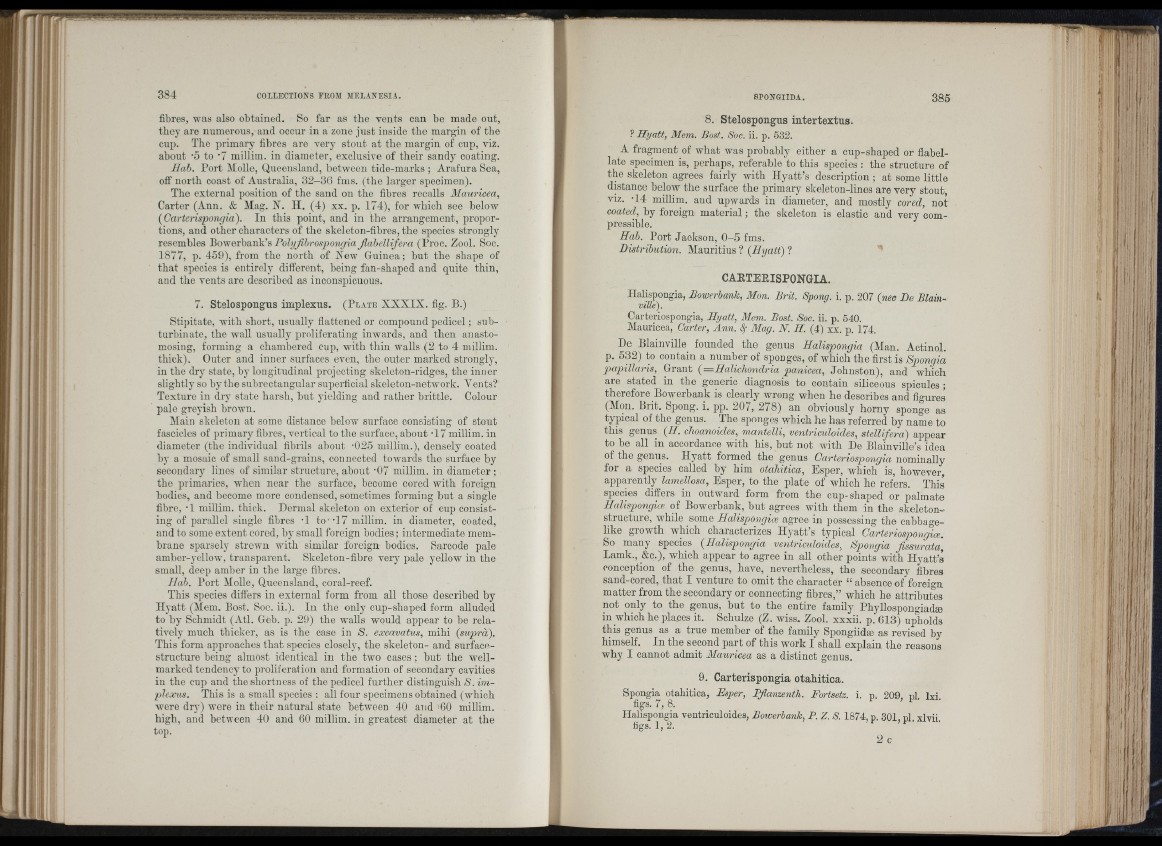
w
Ili
384 COLLECTIONS FEOM MELANESIA.
fibres, was also obtained. So far as the vents can he made out,
they are numerous, and occur in a zone ju st inside the margin of the
cup. The primary fibres are very stout at the margin of cnp, viz.
about ’5 to •? millim. in diameter, exclusive of their sandy coating.
Uab. Port Molle, Queensland, between tide-marks ; Arafura Sea,
off north coast of Australia, 32-36 fms. (the larger specimen).
Tho external position of the sand on the fibres recalls Mauricea,
Carter (Ann. & Mag. N. H. (4) xx. p. 174), for which see below
(Carterispongia). In this point, and in the arrangement, proportions,
and other characters of the skeleton-fibres, the species strongly
resembles Bowerbank’s Polyfihrospongia Jlaheìlifera (Proc. Zool. Soc.
1877, p. 459), from the north of New Guinea; hut the shape of
th at species is entirely different, being fan-shaped and quite thin,
and the vents are described as inconspicuous.
7. Stelospongus implexus. ( P l a t e XXXIX. fig. B.)
Stipitate, with short, usually flattened or compound pedicel ; snh-
turbinate, the wall usually proliferating inwards, and then anastomosing,
forming a chambered cup, with thin walls (2 to 4 millim.
thick). Outer and inner surfaces even, the outer marked strongly,
in the dry state, by longitudinal projecting skeleton-ridges, the inner
slightly so by the suhrectangular superficial skeleton-network. Yents?
Texture in dry state harsh, hut yielding and rather brittle. Colour
pale greyish brown.
Main skeleton at some distance below surface consisting of stout
fascicles of primary fibres, vertical to the surface, about -17 millim. in
diameter (the individual fibrils about -025 millim.), densely coated
by a mosaic of small sand-grains, connected towards the surface by
secondary lines of similar structure, about -07 millim. in diameter ;
the primaries, when near the surface, become cored with foreign
bodies, and become more condensed, sometimes forming but a single
fibre, -I millim. thick. Dermal skeleton on exterior of cup consisting
of parallel single fibres -1 to '-17 millim. in diameter, coated,
and to some extent cored, by small foreign bodies ; intermediate membrane
sparsely strewn with similar foreign bodies. Sarcode pale
amber-yellow, transparent. Skeleton-fibre very pale yellow in the
small, deep amber in the large fibres.
Hab. Port Molle, Queensland, coral-reef.
This species differs in external form from all those described by
Hyatt (Mem. Post. Soc. ii.). In the only cup-shaped form alluded
to by Schmidt (Atl. Geb. p. 29) the walls would appear to be relatively
much thicker, as is the case in S. excavatus, mihi (supra).
This form approaches that species closely, the skeleton- and surface-
structure being almost identical in the two cases ; hut the well-
marked tendency to proliferation and formation of secondary cavities
in the cup and the shortness of the pedicel further distinguish N. im-
plexus. This is a small species : all four specimens obtained (which
were dry) were in their natural state between 40 and >60 millim.
high, and between 40 and 60 millim. in greatest diameter at the
top.
SPONGIIDA.
8. Stelospongus intertextus.
Hyatt, Mem. Bost. Soc. ii. p. 532.
A fragment of what was probably either a cup-shaped or flahel-
latc specimen is, perhaps, referable to this species : the structure of
the skeleton agrees fairly with H y a tt’s description ; at some little
distance below the surface the primary skeleton-lines are very stout,
viz. -14 millim. and upwards in diameter, and mostly cored, not
coated, by foreign m ate ria l; the skeleton is elastic and very compressible.
Hah. Port Jackson, 0 -5 fms.
Distribution. Mauritius ? (Hyatt) ?
CARTERISPONGIA.
Halispongia, Bowerhank, Mon. Brit. Spong. i. p. 207 (nec De Blainville).
Carteriospongia, Hyatt, Mem. Bost. Soc. ii. p. 540.
Mauricea, Carter, Ann. ^ Alag. N. H. (4) xx. p. 174.
De Blainville founded the genus Halispongia (Man. Actinol.
p. 532) to contain a number of sponges, of which the first is Spongia
paqnllaris. Grant (—Halichondria panicea, Johnston), and which
are stated in the generic diagnosis to contain siliceous spicules;
therefore Bowerbank is clearly wrong when he describes and figures
(Mon. Brit. Spong. i. pp. 207, 278) an obviously horny sponge as
typical of the genus. The sponges which he has referred by name to
this genus (H. choanoides, mantelli, ventriculoides, stellifera) appear
to be all in accordance with his, but not with De Blainville’s idea
of the genus. Hyatt formed the genus Carteriospongia nominally
for a species called by him otahitica, Esper, which is, however,
apparently lamellosa, Esper, to the plate of which he refers. This
species differs in outward form from the cup-shaped or palmate
Halispongice of Bowerbank, but agrees with them in the skeleton-
structure, while some Halispongiai agree in possessing the cabbagelike
growth which characterizes H y a tt’s typical Oarteriospongice.
So many species (Halispongia ventriculoides, Spongia fissurata,
Lamk., &c.), which appear to agree in all other points with H y att’s
conception of the genus, have, nevertheless, the secondary fibres
sand-cored, th at I venture to omit the character “ absence of foreign
matter from the secondary or connecting fibres,” which he attributes
not only to the genus, but to the entire family Phyllospongiadm
in which he places it. Schulze (Z. wiss. Zool. xxxii. p. 613) upholds
this genus as a true member of the family Spongiida; as revised by
himself. In the second p art of this work I shall explain the reasons
why I cannot admit Alauricea as a distinct genus.
9. Carterispongia otahitica.
Spongia otahitica, Esper, Pflanzenth. Eortsetz. i. p. 209, pi. Ixi.
figs. 7, 8.
Halispongia ventriculoides, Bowerbank, P. Z. S. 1874, p. 301, pi. xlvii.
figs. 1, 2.
. I
! ' î
) ¡1